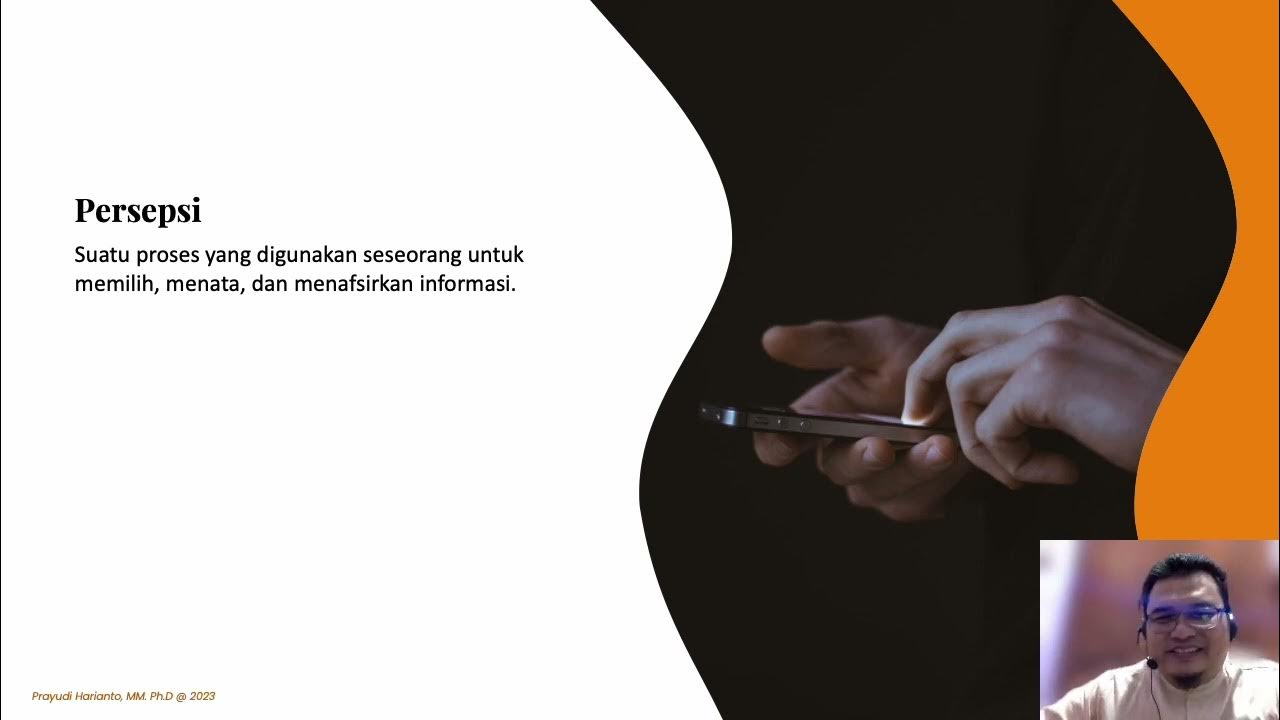Meaning of Perception, perception process, perceptual process, ob, organisational behaviour,
Summary
TLDRThe video explores the concept of perception, illustrating how individuals interpret and understand their surroundings based on their sensory experiences. It discusses how people perceive objects, events, and people differently, influenced by prior knowledge, context, and cognitive processes. The script delves into the difference between sensation and perception, emphasizing how sensory inputs are selected, organized, and interpreted to generate meaning. Additionally, it explains the process of perception, including how we react to stimuli and how these perceptions shape our attitudes, behaviors, and beliefs.
Takeaways
- 😀 Perception is an intellectual and mental process where individuals organize, interpret, and assign meaning to sensory information.
- 😀 Sensation refers to the raw data received through sensory organs, while perception involves interpreting that data.
- 😀 The process of perception involves three stages: input (sensory data), selection, and organization.
- 😀 Sensory information comes from the environment and is processed by sensory organs like eyes, ears, and skin.
- 😀 Perception can be internal (based on bodily sensations) or external (based on environmental stimuli).
- 😀 Perception affects how we interpret the world, such as determining if a smile from someone means they are happy.
- 😀 Cognitive processes, like perception, allow individuals to organize and interpret sensory data to create meaningful understanding.
- 😀 Perception involves not only seeing and sensing but also interpreting meaning from events, objects, and people.
- 😀 In perception, we often make selections based on what is relevant or attention-grabbing, such as when we focus on something that brings us emotional or intellectual meaning.
- 😀 Real-life examples, like seeing a hot surface or watching a movie, show how perception influences our behavior and decisions.
Q & A
What is the difference between sensation and perception?
-Sensation refers to the raw sensory data received by our sensory organs, like seeing, hearing, or touching. Perception, on the other hand, is the process of organizing, interpreting, and making sense of this sensory data to create meaningful experiences.
How do different people perceive the same image differently?
-Different people may perceive the same image in various ways based on their individual perspectives, past experiences, and cognitive processes. For example, one person might see a line as a 6, while another might see it as a 9, depending on their point of view.
How does perception influence behavior?
-Perception influences behavior by shaping how we interpret events or people’s actions, which in turn guides how we respond. For instance, if we perceive a boss’s smile as a sign of happiness, we might approach them with a request, assuming that they are in a good mood.
What are the key stages in the process of perception?
-The key stages in the perception process are: perceptual input (noticing something in the environment), selection (choosing relevant sensory information), organization (arranging the data meaningfully), interpretation (making sense of the data), and output (the resulting behavior or action).
What role does cognitive process play in perception?
-Cognitive processes play a crucial role in perception by enabling individuals to select, organize, and interpret sensory information. This helps them derive meaning from the environment and make decisions based on that understanding.
What is the difference between internal and external perception?
-Internal perception refers to recognizing sensations or feelings within the body, such as hunger, pain, or fatigue. External perception involves interpreting stimuli from the outside world, such as recognizing a smile or interpreting a visual event.
How does perception affect the interpretation of an advertisement?
-Perception affects how we interpret advertisements by influencing whether we view the product positively or negatively. A well-perceived ad can lead to a favorable view of the product, though it may not always result in a purchase, depending on individual preferences and beliefs.
How can the way we perceive a situation change over time?
-Our perception of a situation can change over time as we gather more information, reflect on previous experiences, or undergo changes in mindset. For example, initially seeing a glass as half-empty might shift to half-full depending on a person’s outlook.
What is the significance of 'perceptual input' in the process of perception?
-Perceptual input is the initial stage where a person notices something in their environment that grabs their attention. This could be an object, event, or person, and it acts as the starting point for further selection, organization, and interpretation of sensory data.
How do we select relevant information from all the sensory input we receive?
-We select relevant information based on factors such as personal interest, need, context, and past experiences. For example, when overwhelmed by multiple sensory inputs, we focus on what aligns with our current goals or immediate needs.
Outlines

This section is available to paid users only. Please upgrade to access this part.
Upgrade NowMindmap

This section is available to paid users only. Please upgrade to access this part.
Upgrade NowKeywords

This section is available to paid users only. Please upgrade to access this part.
Upgrade NowHighlights

This section is available to paid users only. Please upgrade to access this part.
Upgrade NowTranscripts

This section is available to paid users only. Please upgrade to access this part.
Upgrade NowBrowse More Related Video

Git & GitHub Tutorial for Beginners #11 - Collaborating on GitHub

Perception Psychology - Psych 101 | Mind Control | Practical Psychology.

Perceiving is Believing: Crash Course Psychology #7

Persepsi Konsumen

Top Down Processing vs Bottom Up Processing (Examples!)

Prayudi Harianto, MM., Ph.D - Persepsi dan Pengambilan Keputusan Individual
5.0 / 5 (0 votes)